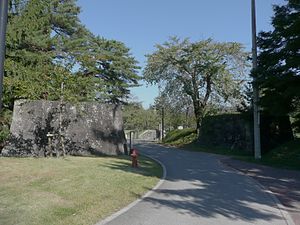Shinjō Castle
| Shinjō Castle | ||
|---|---|---|
|
Shinjō Castle, remains of the main gate to Hommaru |
||
| Creation time : | 1624 | |
| Castle type : | Hirajiro (Lower Castle) | |
| Conservation status: | Partially | |
| Place: | Shinjō | |
| Geographical location | 38 ° 46 '1.3 " N , 140 ° 17' 36.6" E | |
|
|
||
The castle Shinjō ( Japanese 新庄城 , Shinjō-jō ) is located in the city Shinjō in Yamagata Prefecture . In the Edo period , the Tozawa resided there continuously as Tozama daimyo .
history
In 1622 the Mogami were deposed, their castle Sakenobe-jō ( 鮭 延 城 ), located on the Mamuro River ( 真 室 川 ), went to the Tozawa, who came from Hitachi-Matsuoka. Since the castle was not convenient for the administration of the Han , the Tozwa built a new castle two years later. The plan for the castle is said to have been designed by Torii Tadamasa ( 鳥 herr 忠 政 ; 1566–1628), lord of the castle of Yamagata and a stepbrother of Tozawa Masamori. The castle was completed in a year and remained the seat of the Tozawa until the Meiji Restoration in 1868.
Since the Tozawa and the Akita Sataks were on the side of the new government in the Boshin War , the castle was attacked by the Tsurugaoka-Han troops loyal to the shogunate. The castle could not be held by the defenders and was set on fire by them.
The attachment
The castle was a low castle on a narrow headland in the marshland between the rivers Sasunogawa ( 指 首 野 川 ) and Nakanogawa ( 中 野 川 ). The castle, laid out in a rectangular shape, consisted of the central castle area, the Hommaru ( 本 丸 ; 1), to which the second castle area, the Ni-no-maru ( 二 ノ 丸 ; 2), was connected in the west and south . The third castle area, the San-no-maru ( 三 ノ 丸 ; 3), was laid out in the east . Large areas around the inner castle had been left to the samurai (S).
Originally the Hommaru was protected by a castle tower ( 天 守 , tenshu ), but it was lost in fires in 1627 and 1636 and was not rebuilt afterwards. - The stone substructure of the main gate ( 大 手 門 , Ōte-mon , H) of the Hommaru is still well preserved. Walls, earth walls and part of the moat (dark blue in the drawing) around the Hommaru have also been preserved.
The Hommaru is now a park. Its name "Mogami Park" ( 最 上 公園 , Mogami kōen ) reminds of the first princes in this area.
literature
- Mizoguchi, Akihiro: Shinjō-jo in: Miura, Masayuki (Ed.): Shiro to jinya. Tokoku-hen. Gakken, 2006. ISBN 978-4-05-604378-5 , p. 31.



